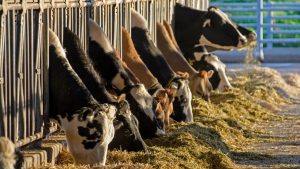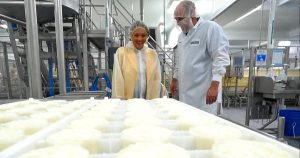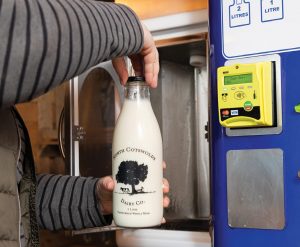
April butter and cheese inventories were below those a year ago. The latest Cold Storage report showed April 30 butter stocks at 337.4 million pounds, up 14.2 million pounds or 4.4% from March, but 24.7 million or 6.8% below those in April 2024. March stocks were revised down 578,000 pounds from last month’s report.
StoneX says this was the smallest seasonal butter build in 10 years, adding “There was plenty of milk/cream available in April so we have to attribute this to demand; increased exports and maybe slower imports. With inventory this low the second quarter stocks/use ratio is looking tighter than last year which would justify a $2.60 per pound average.”
American type cheese stocks climbed to 805.9 million pounds, up 10.3 million pounds or 1.3% from the March level, but were down 19.6 million pounds or 2.4% from a year ago. The March total was revised 2.1 million pounds lower.
The “other” cheese category holdings inched up to 579.1 million pounds, up 753,000 pounds or 0.1% from the March level but were down 16.8 million pounds or 2.8% from a year ago. The March level was revised up 3.4 million pounds.
April’s cheese inventory totaled 1.4 billion pounds, up 10.4 million pounds or 0.7% from March, but down 35.4 million or 2.4% from a year ago. The March total was revised up 5.9 million pounds.
The Daily Dairy Report stated “Cheese stocks have now trailed prior-year levels for 14 consecutive months, but April’s year-over-year decline was the narrowest loss seen in a year.”
The Daily Dairy Report’s Sarina Sharp wrote in the May 23 Milk Producers Council newsletter; “Plentiful milk and high components add up to a lot of cream. Churns are running hard. But US butter is among the cheapest in the world and exports are booming. Domestic consumption is also record high. It was up 3.6% year over year in the first quarter. Insatiable demand for butter helped keep stocks in check.” The March to April build was the smallest since 2014, according to the Daily Dairy Report, which added; “Butter stocks have topped year-ago volumes in every month since January 2024, but in April they fell 6.8% below prior-year levels.”
Rabobank dairy analyst Lucas Fuess, speaking in the June 2 Dairy Radio Now broadcast, credited the Cold Storage report for the strength in dairy prices in the Memorial Day Week, but warned that tariff and trade policy pose “some cloudiness.”
He said limited escalation with Mexico has meant product continues to flow freely and we saw a reprieve in the relationship with China. But, the tariff freeze with China is only for 90 days, he said, and we could see further escalation there so volatility is to be expected.
Worst case scenario would be any escalation of trade differences with Mexico, according to Fuess. “It is in the best interest for both countries to make sure that does not happen,” he said, “Due to the food that flows both ways across that U.S. Mexican border.” He adds that there would be a lot of downside for our whey protein, permeate, and lactose exports in any escalation with China.
Fuess does not see much more rise in cheese prices ahead, due to the anticipated higher supply in the coming weeks but concluded; “Thankfully cheese exports have remained strong at least through first quarter.”
The latest weekly slaughter report showed 44,800 dairy cows were sent to slaughter the week ending May 17, down 1,100 from the previous week, and down 2,200 or 4.7% from a year ago. Year to date, 1,018,400 head had been culled, down 94,300 head or 8.5% from a year ago.
Checking the fields; US corn planting was 87% complete, as of the week ending May 25, up from 78% the week before, 6% ahead of a year ago, and 2% ahead of the five year average. 67% was emerged, up from 50% the previous week, 12% ahead of a year ago, and 7% ahead of the average. 68% of the crop was rated good to excellent.
Soybeans plantings were at 76%, up from 66% the previous week, 10% ahead of a year ago, and 8% ahead of the five year average. 50% were emerged, up from 34% the previous week, 13% ahead of a year ago, and 10% ahead of the five year average.
CME Cheddar block cheese climbed to $1.95 per pound Wednesday, highest since Oct. 3, 2024, but it closed the shortened Memorial Day Week at $1.9475, up 7.75 cents on the week and 13.75 cents above a year ago. The barrels finished at $1.87, 1.75 cents higher, 7 cents below a year ago, and 7.75 cents below the blocks. There were 26 CME sales of block on the week and 13 barrel.
Retail cheese demand is strengthening in the Central region, according to Dairy Market News, and food service sales are steady. Exports are also strengthening. Class III milk is available and cheesemakers say they are purchasing additional loads as low as $7-under class and running busy schedules.
Spot milk availability is mixed in the west with decreasing farm level output in some parts and more educational institutions starting spring recesses. Cheese manufacturers convey that milk is sufficiently meeting needs. Cheese production was steady or stronger following the holiday weekend.
Inventories are extremely tight. Domestic demand is reported as steady, stronger, or in balance with supplies. International buying varies from steady to strong, according to Dairy Market News.
The butter soared 10 cents Tuesday, then added a half cent Wednesday to hit $2.5250, highest CME price since Jan. 27, 2025. It closed Friday at $2.4750, up 5.50 cents on the week but 61.50 cents below a year ago, on 39 sales this week.
StoneX May 27 Early Morning Update attributed butter’s strength to “End-users seeking more price coverage thru year end and into 2026 amid global fat prices that have yet to show material weakness.”
Dairy Market News says milk output is steady in the Central region and contacts report cooler temperatures in parts of the region are leaving plenty of cream available. Ice cream makers are pulling on cream supplies as they prepare for the summer.
Cream multiples are holding steady in the Central region. Butter makers are actively churning, and spot loads of butter are available.
Cream continues to be more than ample in the West, despite milk production decreasing week-to-week for parts of the region, and ice cream production increasing. Cream multiples remained above flat market at mid-week. Churning schedules were steady or stronger following the holiday weekend. Domestic butter demand is steady. Retail demand is described as at or above expectations. Food service demand was termed as down from expectations while export demand is strong, according to Dairy Market News.
Grade A nonfat dry milk climbed to $1.2875 per pound Friday, highest since Feb. 13, up 3.50 cents on the week, and 12 cents above a year ago. There were 14 sales put on the board for the short week.
The Daily Dairy Report’s Sarina Sharp says “The anemic dollar is helping US milk powder compete abroad. That’s boosting export prospects and finally starting to prop up US prices.”
Dry whey closed Friday at 57.25 cents per pound Tuesday, up 3 cents on the week, highest since Feb. 10, 2025, and 15.75 cents above a year ago on 9 sales.
Sharp says “The US accounted for a typical share of China’s whey imports in April, as shipments that arrived last month were not subject to the temporary but significant 145% tariff. Chinese importers stocked up on product and China’s whey imports outpaced April 2024 by 13.9%. There will likely be fewer ships arriving at Chinese ports this month,” she warned. “But US exporters are now rushing to book sales and ship them during the 90-day pause.”
Tuesday’s Global Dairy Trade Pulse saw 4.6 million pounds of product sold, up from 4.4 million on May 13, and the largest Pulse volume since Dec. 31, 2024.
It was the GDT’s 80th Pulse event. The first was held Aug. 9, 2022. The prices on both skim milk and whole milk powder were down from the May 13 Pulse.
Agriculture Secretary Brooke Rollins provided an update this week on the USDA’s ongoing partnership with Mexico to combat New World Screwworm (NWS). Rollins held a call with her counterpart in Mexico, Secretary Berdegue, to discuss the ongoing threat and actions being taken by both countries to contain the threat south of the US border.
“USDA is working daily with Mexico to make sure the resources, tactics, and tools are in place to effectively eradicate NWS,” a USDA press release stated. “Additionally, Secretary Rollins announced that USDA is investing $21 million to renovate an existing fruit fly production facility in Metapa, Mexico to further the long-term goal of eradicating this insect. When operational, this facility will produce 60-100 million additional sterile NWS flies weekly to push the population further south in Mexico. Given the geographic spread of NWS, this additional production capacity will be critical to our response,” says the USDA.
“Our partnership with Mexico is crucial in making this effort a success,” Rollins said. “We are continuing to work closely with Mexico to push NWS away from the US and out of Mexico. The investment I am announcing today is one of many efforts my team is making around the clock to protect our animals, our farm economy, and the security of our nation’s food supply.” Current restrictions on live animal imports from Mexico remain in place, and as previously announced, USDA evaluates the suspension every 30 days.
Meanwhile; The National Milk Producers Federation reported that US and Mexican dairy sectors renewed a partnership and unveiled a work plan to “enhance industry collaboration” at their seventh annual summit convened this week in Madison, Wisconsin. “Industry representatives reaffirmed their shared commitment to strengthening bilateral collaboration and supporting the long-term success of the North American dairy industry,” according to NMPF.
“Led by the U.S. Dairy Export Council and the NMPF on the US side, and by the Confederación Nacional de Organizaciones Ganaderas, Asociación Mexicana de Productores de Leche, Cámara Nacional de Industriales de la Leche, and Consejo Nacional Agropecuario from Mexico, the summit culminated in the signing of a renewed commitment and a shared work plan designed to foster mutual growth and resilience.”
In other trade news, Agriculture Secretary Rollins announced this week that “American dairy producers will have greater market access to Costa Rica, which has approved the first US dairy facility to be registered under their new streamlined approval process. The Trump Administration continues to break down non-tariff barriers, and this latest action is the first of many wins ahead for American dairy producers,” Rollins stated.
“Under President Trump’s leadership, USDA is putting Farmers First. Securing greater market access for American dairy farmers is a much-needed win for the US dairy industry and will give our producers better increased access to a $130 million market in Costa Rica.”
The announcement drew praise the International Dairy Foods Association which stated; “Costa Rica is a market growing in importance for US dairy. After being a net importer of dairy products a decade ago, the United States now exports more than $8 billion worth of dairy products to 145 countries. US dairy exports topped $8.2 billion in 2024, with Central American markets surging, including Costa Rica, Guatemala, and El Salvador all importing record values of US dairy.
In fact, US dairy exports to Costa Rica doubled in value between 2021 and 2024, growing from $31 million to $60 million,” according to the IDFA.
U.S. Dairy Export Council president and CEO Krysta Harden said “We are proud of supporting the great work of the USDA Foreign Service, USDA’s Agricultural Marketing Service, Food and Drug Administration, and U.S. Trade Representative’s Office to painstakingly reach an understanding with Costa Rica to facilitate the export of high-quality US dairy products. This important step recognizes the strength of the US dairy regulatory system and deepens bilateral engagement under the CAFTA-DR at a key time for US-Costa Rica trade relations.”
Back on the home front; milk production varies in each geographical region, according to DMN. The East and upper Midwest are holding steady as the spring flush draws to an end, while western states are seeing a decline in milk output. Some areas are seeing a decline in milk components as the days get warmer however cream supplies are still sufficient to meet demand, says DMN.
Class I milk production is declining nationwide, predominantly due to the end of the spring semester. Class II production is increasing nationwide. Ice cream manufacturers are producing more volumes of ice cream to account for the summer demand. Milk for Class III use was steady to stronger this week.
Looking “down under,” DMN reports “Portions of South Australia, New South Wales, Victoria, and Tasmania experienced continued dry conditions in April, despite above average rainfall in northeastern Australia. Milk production data showed total output at 594 million liters, up 0.4% year over year.”
New Zealand output hit 1.46 million metric tons, down 0.5% from a year ago. “Weather conditions turned in April as remnants of Tropical Cyclone Tam resulted in higher-than-average rainfall across the country,” according to DMN.
This column was written for the marketing week ending May 30, 2025.
Lee Mielke is a syndicated columnist who resides in Everson, Wash. His weekly column is featured in newspapers across the country and he may be reached at lkmielke@juno.com.
You can now read the most important #news on #eDairyNews #Whatsapp channels!!!
🇺🇸 eDairy News INGLÊS: https://whatsapp.com/channel/0029VaKsjzGDTkJyIN6hcP1K























